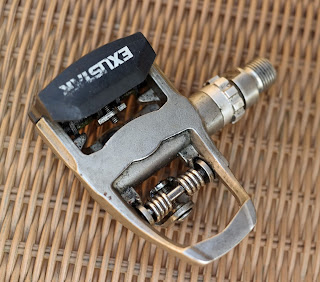Well, I've made time to strip the TW Bents Yak homage trailer, ready for some modifying and makeover magic. Disassembly was remarkably straightforward. Once I 'd worked out how the press fitted bushing/bearings were instated.
I prefer the single wheel designs, since they track with the bike's movement but all systems have their pros, and indeed cons. https://www.sevendaycyclist.com/tug-jobs
It was a welcome surprise to discover they'd been treated to some plastic-friendly grease, which assisted their, undamaged extraction. Only modest amounts of controlled force and primal grunting ensued.
Formative discussions with Maldon Shot Blasting & Powder Coating erred toward a chrome effect swing arm, top rail and either a buttermilk (Interpon 610) or gloss black base/frame. The chrome effect providing some reflective safety, the gloss black timeless, and easy to touch up, as required.
However, I've since decided that chrome throughout, is the best option.
Keeps things uniform and is arguably the most efficient use of time and other resources.
Chris was doing some more wet spray work, this time on what appears to be an old De Rosa, and this carbon fork, which will be matt blue, once the lacquer is applied.
Seems good quality. mass-produced (26 inch mtb) forks are now rarer than hen's teeth. Given my Univega's design brief, Carbon's a non-starter. A bespoke steel set, was another option. Disc and canti, mudguard and front rack mounts...
However, while I'm a firm believer in paying skilled people appropriately, there had to be another option. Especially since I was only looking to save a few grams...Lo and behold!
While rummaging through my spares stash, seeking inspiration, I rediscovered it's original pair.
The original flamboyant red enamel was showing some cosmetic damage.
Otherwise, not rot or other nastiness. Crown race liberated, Graham has kindly agreed to blast and refinish them, in gloss black powder coat. Note to self. Mus remind them to soak in methyl chloride tank, as they've been Waxoyled. Be interesting to see, if these also sport a nickel plated layer beneath the paint... https://www.sevendaycyclist.com/after-the-gritters-went-home
Too much Mad Max, at an impressionable age, perhaps but I have a quiet appreciation of matt black, and indeed other, slightly distressed effects. Nonetheless, gloss and satins rule my roost.
A curious rattle, experienced when traversing washboard tarmac suggested my fixed gear winter/trainer's chain needed tensioning again. Closer inspection revealed it was the Halo Fix G Track hub's https://www.sevendaycyclist.com/halo-fixed cassette style lockring. I was surprised by just how loose it was. Note to self! Check more frequently!
Wheel out, tool in, 40nm torque-sorted. Presented the ideal opportunity to instate the threaded side's cover, along with a light lick of grease. Keeps things looking sleek, and sheltered from grot. I also decided to swap to a Sram chain, since I was about it.
Nothing wrong with the Passport Elements Single Speed Chain https://www.sevendaycyclist.com/passport-elements-single-speed-chai whatsoever. However, my long term experience suggests it's best for single-speed and hub geared, rather than fixed builds forgoing a rear brake. Especially, if you live/ride in hillier regions. For many, simplicity is fixed's main draw.
However, its important to remember the stresses placed upon a fixed setup, doesn't permit sloppy maintenance. For me cheap chain, hubs and sprockets are false economy. I'd still be inclined towards a 1/8th chain- even on 3/32 sprockets.
Despite the persistent, showery conditions I'm still running the Zefal Pro-Dry Chain Lube. Love the low friction, serene swoosh and indeed, its penetrant qualities. It literally seeps into the chain's inner sanctum, which made removing the joining pins, a breeze.
Not quite so clean-at least compared with long cure, barely there ceramics, including Weldtite TF2 Ultra Dry Chain Wax https://www.sevendaycyclist.com/weldtite-tf2-ultra-dry-chain-wax ; or indeed Rock n' Roll Absolute Dry Chain Lube https://www.sevendaycyclist.com/rock-n-roll-absolute-dry-chain-lubr
The SRAM does seem a bit meatier, although I'll keep the Passport. According to my digital gauge, it's only a quarter worn, and could still come in handy... Muc-Off sent us some interesting samples of their lubes and polishes, this week. Well, keeps me out of mischief....






















































